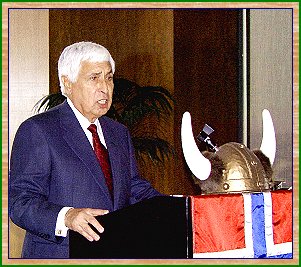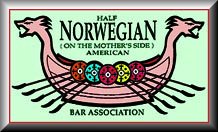|

This year, the
1000th anniversary of the Vikings’ discovery of America is being celebrated.
For some reason I cannot fathom, I have been asked to discuss the expedition
of Leif Ericson.
Unlike my distinguished predecessors Mildred Lillie, Paul Turner and Larry Crispo, I am not an expert in Medieval Scandinavian history. I will, despite this slight handicap, provide an authoritative discourse on a subject I know absolutely nothing about.
Accordingly, there will absolutely be no question-and-answer period — unless you want to ask me about life after unification [of the county's trial courts] or the need for a dual grand jury system. Now, of course, every school child knows who the first European was to set his eyes on the land to the west that has come to be known as North America. Yes, you've got it: it was Bjarni Herulfson. It was in 986 that Bjarni, a trader, set sail from Iceland, intending to land in Greenland. A fierce storm arose, and was blown far off course. REALLY far off. He became sort of a Captain Janeway of the Tenth Century. After many days, he sited heavily forested land to the west. This surely was not Greenland — a land which was always covered with ice. But Bjarni was too impatient to stop and look around. Continuing northward, he sited more land to the west, but did no more than take note of its existence. Bjarni will be remembered for his utterance, "I came, I saw, and what more did you expect?" Bjarni finally arrived at his destination and watching as the boat landed was a boy in his late teens. His name was Leif Ericson. Leif followed Bjarni into a hall where the trader told his tale of the land to the west. Now, who was this lad, Leif? He was the son of the head man of Greenland, Eric Thorvaldson — better known as Eric the Red, so named because of his red hair. Thorvaldson was a Norwegian, but had been declared an outlaw and banished from Norway after slaying an adversary. While that might strike some as a pretty light penalty for killing a man, I would — at least in front of this group of Norwegian lawyers — be loathe to dispute the proposition that exile from Norway was as cruel a punishment as might be devised. Torvaldson went west to Iceland, a Norwegian settlement, where he married and settled down on a farm. Leif was the eldest of the couple’s four children, born around 970. Well, it seems that Thorvaldson, though now a family man, was just not able to change his ways. In 982, he got into a quarrel and again killed a man. This time he was banished from Iceland for three years. It is fellows like this recidivist who a thousand years later inspired the "Three Strikes" legislation. Unable to return to Norway, Thorvaldson gathered his wife and children and some slaves and set sail, determined to ascertain the reliability of rumors of land to the west. After a few days of sailing, he did, indeed, discover land. Despite it being ice covered, he denominated it "Greenland." According to legend, Eric said, "it would make people want to go there if the country had a good name." Time Magazine suggests that this "might have been a clever bit of salesmanship." In 985, Eric came back to Iceland to round up folks to resettle on this prime real estate. He had the settlement laid out in his mind — the country club here, the tennis court there, and the pool in between. He convinced a lot of folks, and 25 ships sailed from Iceland to Greenland, 14 of which actually made it. Greenland now had a population in excess of 700. Enough folk were there that it was evidently worth the while of our friend Bjarni to get there to conduct business. His tale of the land to the west inspired the desire on the part of those more inquisitive and intrepid than he to journey to this land. That was to happen. But before discussing the expedition of Leif Ericson, it’s about time to interject a discussion of the personal lives of the principals in this story. Leif, in the late 990s, decided to go off to his father’s homeland, Norway — a journey which was common for sons of prominent families in the Norwegian settlements. His ship was blown off course and he landed on an island west of Scotland. He was welcomed into the house of the lord of the island, and spent most of a summer there — and for Leif and the lord’s daughter, Thorgunna, it was a steamy summer, indeed. Nine months later, Thorgunna became a mother of a son. Years later, when Thorgunna brought the child to Greenland, Leif acknowledged him as his son, and, following Leif’s death, he became the leader of Greenland. Leif finally reached Norway and stayed with the king through the winter. I can only speculate that he preferred the summer with Thorgunna. Anyway, King Olaf had converted to Christianity and was able to convert Leif. Leif gave his word he would make efforts to convert the people of Greenland. Back in Greenland, he was true to his word. His mother was among the converts. His dad was not! Following her baptism, the mother vowed she would not be a complete wife to Thordvaldson until he, too, became a Christian. From that time forward, they had twin beds. Bjarni’s tales of land to the west were told and retold, and the mysterious land he had spotted sang out to the Norsemen, like Bali Hai. Originally, Torvaldson was to lead the expedition — but after falling off his horse, he realized he was too old to make the journey. So it was that Leif and a crew of about two to three dozen men set out to validate Bjarni’s claims that land existed out west. They landed on the North American Continent and remained for the winter. While Bjarni was the first European to sight the New World, Leif and his party were the first European tourists. Every year since 1964, the president of the United States has proclaimed Oct. 9 as Leif Ericson Day. Leif’s exploits, and those of other Vikings, were chronicled in a recent issue of Time Magazine which stated of the Vikings: "They reached Rome, Baghdad, the Caspian Sea, probably Africa too." The writer left out Mexico. I have absolute proof that the Vikings went there, too — and pilfered some recipes. This ancient Norwegian food we have been treated to today, lefse, obviously is a mangled version of the flour tortilla. On that culinary note, I wish you all a happy Norwegian Independence Day. |

